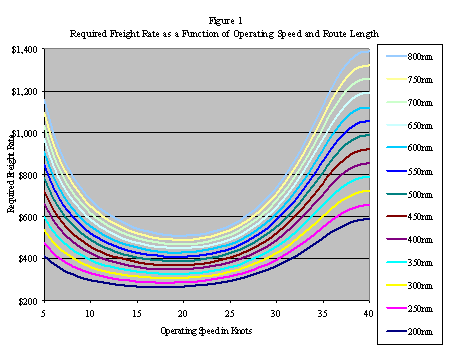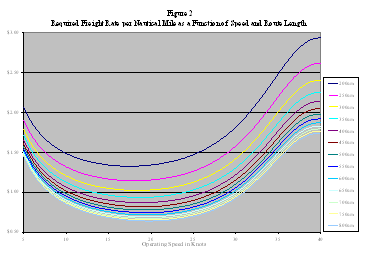|
|
 Gary A. Lombardo, Ph.D |
|
|
 Gary A. Lombardo, Ph.D |
An Economics Perspective
1This article is the second in a series of three articles addressing short sea shipping issues. The reader may recall the first article which appeared in the December/January issue of WWS/World Wide Shipping. Briefly the first article reported the results of a survey questionnaire administered to maritime professionals that was part of a research report
1 examining the issues and prospects of short sea shipping. The article summarized the findings as follows:Roll On/Roll Off Vessels
Short sea shipping can operate in several different
alternative modes: container carriers, roll on/roll off vessels, and an
integrated tug-drawn barge service. Although it is likely that at some point in
the future, all three conceptual models will operate in parallel, this article
will address the economics of the RoRo alternative.
RoRo vessels would be especially well suited for most SSS
service. They offer the shortest cargo turn around time at both route terminals,
as well as call for the minimum investment in port infrastructure. No cranes are
required for container loading – in fact, RoRos could carry conventional
tractor-trailers as readily as containerized ones. This improvement in
flexibility is a distinct advantage to both SSS operators and their customers.
No large yards for transient container storage are required, only a parking lot
sufficient for parking one ship load of tractor-trailers, with perhaps 20%
excess capacity for overflow. Delivered cargo is intended to be driven away from
the terminal as soon as it can be driven off the ship. Loading ramps can be
built into the ship itself, or provided as part of port infrastructure, though
it appears obvious that two ramps, one at each port terminal, that would service
many ships, would offer significant savings over fitting each ship with its own
ramp system or systems.
The shortcoming of the RoRo concept is that at least
approximately 30% of weight and volume capacity has to be devoted to carrying
the tractor-trailer cabs, and even containerized tractor-trailers can never be
packed nearly as densely as on a containership. RoRo benefits compared to
container carriers diminish the longer the route. Traditionally, RoRo service
has attracted higher-value freight, and charges higher freight rates, which are
justified by the faster port turnaround. In short sea shipping, the relevant
comparison is not so much with container carriers or an alternative shipping
configuration, but with the overland interstate trucking or railroad freight
which is never handled by the maritime industry.
Required Freight Rates and Optimal Operating Speeds
Water transport rates evolve over time. Between 1979 and
1992, the average increase in freight rates for all types of ocean transport has
been 3.096 percent per year, which closely approximates the inflation rate over
this period. Below we will consider the costs involved in operating a RoRo
service and determine the required freight rate (RFR) the operator must charge
to break even. This RFR must be significantly lower than the standard overland
freight rate of approximately $1.25 per statute mile for SSS to be considered
economically viable.
Baseline assumptions for estimates presented graphically
below are that short sea shipping is initially instituted with a single RoRo
vessel designed to carry 80 tractor-trailers. These assumptions are
conservative, and SSS operators should depart from them if and only if such
departures provide additional cost savings. The RFR results from the size of the
ship and the operating speed. Figure 1 graphs RFR as a function of operating
speed, which is allowed to vary between five and forty knots, for different
route lengths, which are allowed to vary between 200 and 800 nautical miles.

From Figure 1 it appears that the optimal operating speed
always falls in a range approximately 18 to 20 knots. The RFR curves are
extremely flat near their minima, meaning the diseconomies of marginally faster
operating speeds are not particularly punishing in terms of imposing additional
costs and calling for higher RFRs. Figure 1illustrates that the greatest
operating economies occur with operating speeds of around 20 knots. While lower
speeds reduce costs and fuel consumption, they also impose the cost of making
fewer runs each year between fixed endpoints of various lengths between 200 and
800 nautical miles, meaning fewer trucks can be removed from highways. Higher
speeds allow more trips, but impose higher operating costs in terms of fuel
consumption.
Note that in Figure 1, minimum RFR rises more slowly than
route length, indicating that the cost advantage of SSS increases on longer
routes. This improvement in economy is only limited by the feasible limit of SSS
service, which, due to the geography of the U.S. East, Gulf and West coasts,
cannot be implemented over routes much longer than 800 nautical miles. Dividing
minimum RFR, a measure of operational cost, by route length, gives minimum RFR/nm,
a measure of cost per nautical mile traveled. Minimum RFR/nm does not reach a
minimum over the distances relevant for SSS, indicating that, for the relevant
distances, the cost advantage for SSS increases as the distance carried
increases. This is illustrated in Figure 2.

Figure 2 shows the same RFR values as Figure 1, but divided
by the route length to get RFR/nm of freight carried. The RFR/nm compares
roughly with the cost per statute mile charged by truckers. SSS operators should
not seek to undercut interstate trucking or railroads beyond the minimum amount
necessary to assure full capacity on each SSS trip. SSS operators should then
take advantage of their significantly lower costs to operate at a higher profit
margin.
The RFR per nautical mile carried can be compared with the
overland shipping rate charged per statute mile, approximately $1.25. This
allows us to conclude that SSS routes less than 200 nautical miles cannot
undercut the costs of overland operators, and thus cannot compete effectively.
More importantly, SSS can compete on longer routes, and its cost advantage
increases dramatically the longer the route. On an 800 nautical mile route, SSS
has approximately half the cost of overland shipping. Charging only a small
amount below what truckers charge, sufficient to ensure vessels sail fully
loaded, ensures SSS operators a higher profit margin.
Government subsidies
The data presented above demonstrate SSS can provide
private ship owners significant profits. There seems to be an implicit belief
that SSS cannot compete effectively with interstate truckers or railroads. It is
also felt that since SSS seeks to address critical problems outside the maritime
industry, highway traffic congestion and pollution, government subsidies are
justified and will render SSS profitable, at least initially. In fact, SSS can
be implemented without subsidies, and subsidizing SSS cannot serve the public
welfare. If private owners cannot earn profits engaging in an activity,
consumers do not sufficiently value that activity to justify its performance.
It may also be argued that the government subsidizes
competing overland transportation, and that SSS cannot compete with subsidized
transportation unless it receives an equal and comparable subsidy. This only
makes a case for removing the subsidy on the other forms of transportation.
There remain legitimate spheres where the government can play a financial role.
The government can utilize SSS as a customer, taking advantage of cost savings
and lowered environmental impact. The government can utilize SSS to move the
mail, defense equipment and troops, critical war materiel, etc., bypassing
potential bottlenecks in overland transportation networks. The government can
rebate fuel and vehicle use taxes to SSS customers, to reward them for cutting
down on pollution and relieving congestion. The government can create a tax
environment favorable to SSS operators and their customers, including but not
limited to, permitting accelerated depreciation, tax rebates, and tax cuts.
Because overland shippers, the potential customers of SSS,
pay significant taxes and user fees, mostly to state governments, part of these
taxes can be rebated. Every mile a truck is carried over the SSS network
translates into one less mile traveled over the interstate highway system.
Rebating highway and fuel taxes rewards truckers for the role they would be
playing in lessening the congestion experienced by other truckers and personal
autos using the interstates, and for mitigating environmental impact.
Summary
In summary, given the lack of operational cost and revenue data, the theoretical analysis indicates that short sea shipping operators can be profitable. In this case, the government’s primary role should be that of a short sea shipping customer and not in the role of providing subsidies to the operators. In this way, operators may secure government contracts as they establish their enterprises to project revenue streams to offset fixed costs. This government contribution will then provide, in effect, a funding mechanism for short sea operators to market their services to the private sector to generate revenue for profitable operations. {}